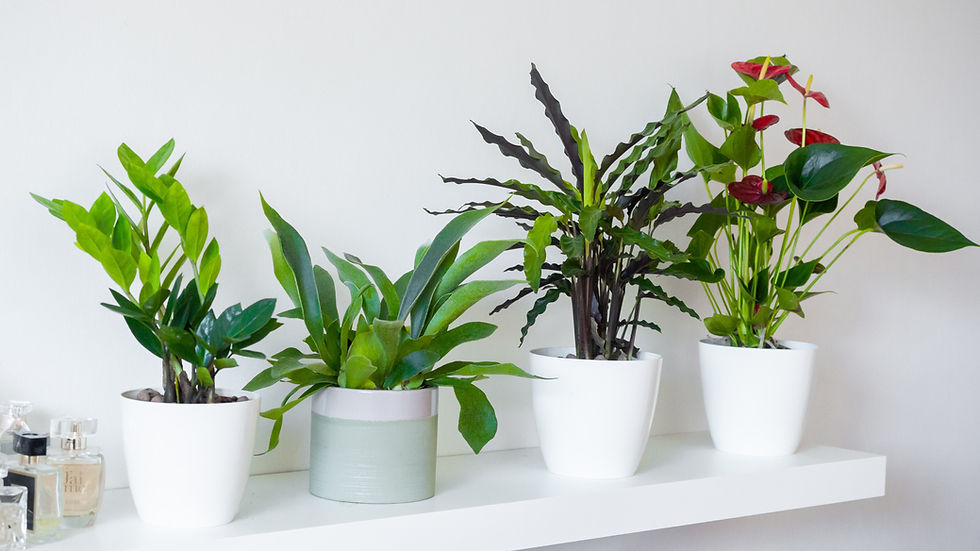Autumn Oak Lane: What I would #planthaul if I were a YouTuber
- Justin Williams

- Dec 10, 2020
- 2 min read

1. African Mask Plant
These plants are part of a species marked by the common name of elephant’s ears. they are easy to take care of and make a great candidate for a houseplant. They are tropical plants that love humid atmospheres and are easy to prune if their leaves get dry. They want bright indirect light - do not expose them to direct sunlight. Watering these plants should be done in the morning so they can dry in the evening. If the soil dries in the winter they might go dormant for a little while. If so, dig up the corm and allow it to keep over winter and put it back in new soil in the springtime when there are warmer temperatures. These plants will add a depth of dimension to the background in any atmosphere.
2. Rex Begonia
These plants are quite finicky to keep alive. They come in many different shapes and sizes; they have been bred through the years to produce many different cultivars. They need humid air and distilled water as they are used to getting rainwater or purified water. Some variants like moist soil and indirect light. These plants add a classy, well-kept arrangement to every household collection.
3. ZZ Plant
The Zamioculcas zamiifolia plant is an easy plant to take care of. With its underground tubers and thick roots, this plant is capable of taking abuse in a standard pot. If you want more plants, you can propagate it by division. When you go to repot the specimen, you can divide the tubers and place them in their own pot. These make a great countertop plant or windowsill additive to enhance the indoor landscape as well as a vertical interest.
4. Cape Primrose
Cape Primroses like bright light, but the leaves will scorch if they are put in direct sunlight. Water the soil until the roots are wet and let it dry in between waterings. The leaves will turn brown if they are left in water. They thrive in humid climates and hail from South Africa, so they are accustomed to higher temperatures. These plants offer lovely flowers and elongated leaf structures that hang over the pot.
5. Helleborus (Lenten Rose)
These plants are perennial and are in the buttercup family. They are toxic to animals as well as humans. They are evergreen and come in many different bloom colors. These plants form next year's bud at ground level below the leaf structures, so don’t cut them back, or maintain them in a pot inside. You can transplant them outside in the springtime in part-sun or shade.
6. Bromeliads
These plants provide ample interest to a shelf or countertop they are placed on and bloom spikes with colorful gradients. They are epiphytes and grow on trees in tropical forests and do best in the orchid growing medium. These plants are short-lived and after about two years they produce offshoots on the side of the stems and produce pups. You can pot these plants after they are big enough to send off anchoring roots.








谷歌蜘蛛池搭建
谷歌快排
谷歌外链代发
谷歌留痕
谷歌蜘蛛池出租
谷歌快速排名
海外引流渠道
Telegram搜索引擎排名
巴西引流软件
谷歌霸屏技术
谷歌外推软件
四方支付系统
四方支付源码系统
四方支付系统源码
四方支付程序
四方支付平台源码
四方支付系统搭建
四方支付程序
四方支付平台搭建
四方支付系统源码
四方支付系统
四方支付系统
谷歌蜘蛛池搭建
go语言四方支付
四方支付系统源码2025
美国毕业证办理
四方支付
四方支付系统
国外毕业证书
办理美国毕业证书
美国留信认证
美国毕业证书
购买美国毕业证
美国留信认证
真实留信认证
留信认证
毕业证成绩单办理
购买美国留信认证
办理英国毕业证书
英国毕业证购买
英国毕业证书成绩单
订购英国学位证书
制作英国毕业证书
购买英国学位证书
英国文凭等级划分
定制英国毕业证书
补办英国毕业证
英国毕业证购买
BCH Miner BCH Miner
BCH Miner BCH Miner
BCH Miner BCH Miner
BCH Miner BCH Miner
BCH Miner BCH Miner
BCH Miner BCH Miner
BCH Miner BCH Miner
BCH Miner BCH Miner
BCH Miner BCH Miner
BCH Miner BCH Miner
BCH Miner BCH Miner
BCH Miner BCH Miner
BCH Miner BCH Miner
CESUR Mining CESUR Mining
stainless steel sheet stainless steel sheet
AV在线看 AV在线看;
自拍流出 自拍流出;
国产视频 国产视频;
日本无码 日本无码;
动漫肉番 动漫肉番;
吃瓜专区 吃瓜专区;
SM调教 SM调教;
ASMR ASMR;
国产探花 国产探花;
强奸乱伦 强奸乱伦;
AV在线看 AV在线看;
自拍流出 自拍流出;
国产视频 国产视频;
日本无码 日本无码;
动漫肉番 动漫肉番;
吃瓜专区 吃瓜专区;
SM调教 SM调教;
ASMR ASMR;
国产探花 国产探花;
强奸乱伦 强奸乱伦;
代发外链 提权重点击找我;
谷歌蜘蛛池 谷歌蜘蛛池;
Fortune Tiger…
Fortune Tiger…
谷歌权重提升/ 谷歌权重提升;
谷歌seo 谷歌seo;
谷歌霸屏 谷歌霸屏
蜘蛛池 蜘蛛池
谷歌快排 谷歌快排
Google外链 Google外链
谷歌留痕 谷歌留痕
Gái Gọi…
Gái Gọi…
Dịch Vụ…
谷歌霸屏 谷歌霸屏
负面删除 负面删除
币圈推广 币圈推广
Google权重提升 Google权重提升
Google外链 Google外链
google留痕 google留痕